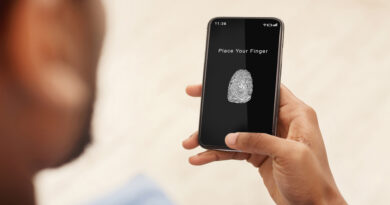Biometrics for Smartphones: How Reliable & Secure are they?
You might have encountered numerous instances where security overlaps privacy and your smartphone is one of them. From stone-age security protocols of setting a password or PIN on smartphones, deny the trespassing access when you aren’t around your smartphone. However, such security standards have upgraded and evolved into biometric fingerprints and FaceID to help you unlock your smartphone at one glance.
Smartphone manufacturers are planning to surprise users with the new biometrics innovations, the question arises whether these biometrics are really effective enough. As users find it extremely easy to set a FaceID or fingerprint, they are getting more inclined to these facilities.
Eminent smartphone manufacturers have to work on adding new technology so that users need not compromise their security standards. Let’s learn about different biometrics used for smartphones and evaluate their efficacies.
Most Common Biometrics for Smartphones
Users prefer recent innovations in biometric technology, and they are fingerprint and face unlock. While it takes a second or two, it doesn’t mean that such biometric technologies are completely reliable.
Yes, it’s possible to bamboozle the super modern sensors of your smartphone if any trespasser uses the right trick. Biometrics are not fully trusted for smart home service ambiance, too.
Fingerprint Locks
The advantage of fingerprint lock and unlocking strategies is that they appear instant and very convenient to use. You can set them at any time and you feel it is highly secure. All of us are born with distinct fingerprints and nobody can copy that. If you are convinced of this then think twice.
Hackers can easily trace your fingerprint from the body of your smartphone. Even they can use a high-resolution photo of your fingerprint to access the smartphone. Whether it is the key access to your social media or private banking details, nothing remains private at all with fingerprint locks.
However, this doesn’t convert the fingerprint lock entirely vague. You still can use fingerprint locks where people can follow the PIN or unlocking pattern over your shoulder. For such instances, fingerprint locks are extremely reliable. Additionally, it provides you with immediate access to your favorite application.
Face Recognition
As the statistics are indicating, almost a billion smartphone users are currently relying upon facial recognition or authentication for keeping their devices safe. Moreover, some are even using their facial contours and other details to provide permission with the banking transactions through payment applications. But, the current scenarios of failing face recognition systems on Android devices might threaten your security and privacy.
You can clearly imagine that a hacker can gain access to your smartphone by using any of your images or video. And, if the sensor, computer, and associated software can’t detect the flaw between the real you and your imagery, then face authentication is potentially a threat. However, Apple has performed benchmark innovations for making the FaceID flawless. It would allow access only if the person’s eyes are open. Moreover, it can differentiate the face details between siblings as the iris recognition technology has got its back.
Keeping all the controversies aside, FaceID of iPhones is comparatively more secure. And, they can help you unlock the smartphone especially when you can’t use your hands to type the PIN or password.
PIN & Password
Smartphone PINs and passwords might not seem as advantageous as the former twos. But, no smartphone manufacturer misses installing these two security features in any smartphone, till date. However, these are not so-called biometrics, but you can lock your phone with them. And, there might be a valid reason why the manufacturers haven’t discarded the technology.
Most of the PIN facilities of smartphones ensure that it formats everything on the device once any trespasser inserts the wrong PIN, ten times at a stretch. And, it can take a long time to guess your PIN or password on your smartphone. But, you can change the PIN at any time, before the hacker gets hold of the previous one.
However, guessing a PIN can be done with an indefinite number of assumptions. And, mostly, smartphone PINs are of four to six characters only. Whereas the passwords might stretch to eight characters or so. Here, patterns might appear more secure, but they aren’t.
5 Ways to Enhance the Effectiveness of Biometrics on your Smartphone
Well, you can’t escape from such biometric technologies if you want to keep your device and data safe. You have to utilize the same biometric techniques despite the fact that they are not fully secure. However, you can improve your experience with biometric safety and security with some simple security codewords. Here they are:
Always Invest your Endeavour and Time in Strong Password
If you have been too lazy to decide a strong password, then your device is not safe at all. Experts of smart home service always suggest deploying a hard-to-crack password. Additionally, it should consist of different case letters, symbols and special characters. And, you should limit the use of the password to a single device.
Use Multi-Factor Authentication
In case your smartphone permits you to enable multi-factor authentication, then switch it on. And, you can rely on a PIN or password after any modern authentication process. For instance, you can go for face recognition or iris recognition followed by a PIN or password. Thus, your device would feel safer. Avoid smartphone locks engaging patterns.
Keep Updating the Device Software
Settle for branded smartphones as the manufacturing authority often releases security patches for the devices. And, you should keep installing them so that the device can adopt new software modifications. On the other hand, you might activate the automatic updates on your device for better reliability.
Don’t Join Any Wi-Fi Connection near you
Trusting any Wi-Fi connection out there would be of no wisdom. If anyone tries to invade your smartphone details through Wi-Fi biometrics can’t resist them from doing so. Therefore, refrain your smartphone from connecting to public Wi-Fi networks. Only go for tried, tested, and trusted ones.
Forget Smart Lock Options
These sound good when you are at home. Such a lock strategy can weaken your connectivity passages. For example, your smartphone might get exposed to determining a specific location, or a definite Bluetooth connection. Disable such advanced lock options if you don’t want to compromise your smartphone’s security.
Challenges with Biometrics
The first and foremost concern with them is that they can be copied. Any smart hacker can take a high-resolution image of yours or collect your fingerprint from the glass you have used. And, he/she can use those details to get access to all the details on your smartphone.
On the other hand, the government is still on the way to progress when you take biometrics into account. So, use biometrics with multi-factor authentication supported by PIN and lengthy passwords. However, consider encrypting the applications with suitable authentication on your smartphone, as well.











